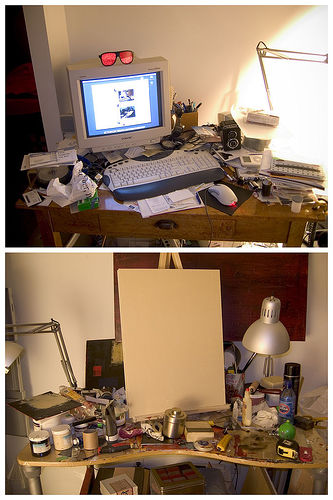Like too many calendars or to-do lists, duplicates create confusion, decrease productivity and increase your chances of forgetting something important.
On occasion, I work with a client with two home offices. Not in two different homes, but in the same house. And they are not happy. They all have reasons for two home offices:
- Their work has out-grown their original office and has invaded an adjacent room,
- The internet outlet is in one space but they prefer to work in another space, or
- They have not found a room in their home that feels right as a home office.

Two work spaces not working. Commuting from work space to work space leads to chaos.
One client had combined her home office and her mediation/yoga space in the same room. This meant she could not bring in the office storage she needed. We found a cozy space near her bedroom where she could do her yoga and meditation. She joked she could now walk into her meditatation space before she completely woke-up in the morning and had a chance to talk herself out of her practice.
Another client liked working near the windows in one room, but her computer was in another room. We moved the desk from a position she did not feel comfortable in, to a place near a window. As luck would have it, we discovered a cable outlet behind the window curtain . (otherwise we could have used cable extension cords along the baseboards compliments of RadioShack or Amazon, or set up WiFi.) There is no need to be chained to a cable outlet.
A third client had not found a space in her home that felt right for her home office, so she migrated between the family room, two empty-nest guest rooms (one with a business office desk she disliked and the other with an antique desk that she loved but was too small) and her kitchen. Every time she tried to work, what she needed was in another part of the house. Very frustrating and very inefficient. We moved her treasured old desk into a spare bedroom and arranged bookcases and artwork around to make the room feel like hers. Much different than the previous set-up that felt like a corner she borrowed from someone else.
All three clients where thrilled with the changes and to have comfortable, functional home offices to call their own, to place all their files and have a single desk/table that really works for them. To have one place where they could leave things out if need be. To have a space that is dedicated to each and her worklife.
Not only had these clients established a single, consolidated workspace, but they were working with their brain’s hard wiring. Neuroscientists have discovered that memory needs context – the context being the environment in which a thought or idea arose. Waking through a doorway seems to break context for the mind. You lose your chain of thought. Identifying one space for work helps you hold onto a thought and work more efficiently.
Plus, it might be tricky getting a home office tax deduction when you claim two spaces.
If you want help setting up an office that really works for you, contact Linda
Do you work in more than one space? What are the pros and cons? How do you make it work for you?